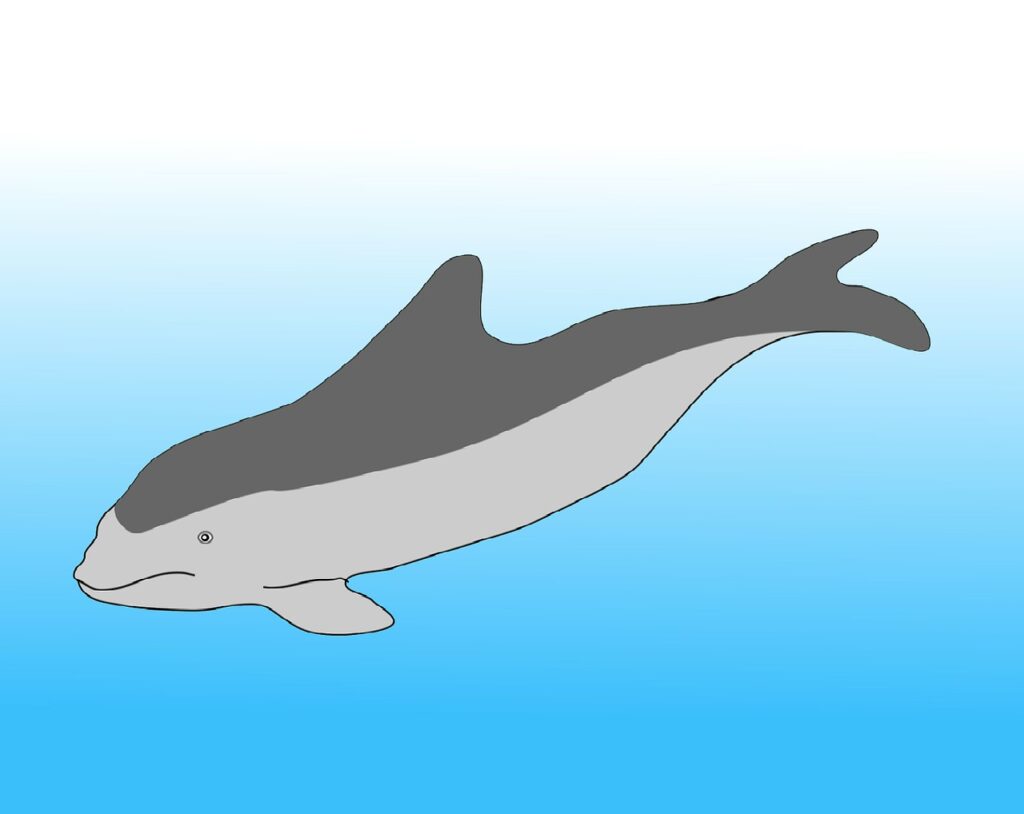The Yangtze River is home to a mysterious creature – the finless porpoise. Are they friendly? Let’s explore!
These porpoises have an alluring look and curious behaviour. But beneath the surface, a more complex reality is revealed. They can communicate with clicks and whistles – forming bonds to navigate their social structure. Plus they’re smart – problem-solving and adapting to different environments.

Sadly, their habitat has been damaged by pollution and human activities like fishing and dam construction. This has caused their population to plummet.
It’s time to act! Conservation measures and awareness about preserving habitats will help humans and finless porpoises live in harmony.
Key Takeaways
- The Yangtze finless porpoise is a critically endangered species that is native to the Yangtze River in China.
- Despite their friendly appearance, these porpoises are facing numerous threats, including habitat loss, pollution, and overfishing.
- Efforts are being made to protect and conserve the Yangtze finless porpoise, such as establishing protected areas and implementing stricter fishing regulations.
- The porpoises are also being studied to better understand their behavior and biology, which can aid in conservation efforts.
- Public awareness and education campaigns are crucial in raising awareness about the plight of the Yangtze finless porpoise and encouraging people to take action to protect them.
- Collaboration between government agencies, conservation organizations, and local communities is essential for the long-term survival of this species.
- The decline of the Yangtze finless porpoise is not only a loss for biodiversity but also a reflection of the overall health of the Yangtze River ecosystem.
Background on Yangtze Finless Porpoise
The Yangtze Finless Porpoise is an amazing aquatic mammal found in the Yangtze River in China. Human activities, such as pollution and habitat destruction, have caused many challenges for this species. To help with conservation efforts and raise awareness about their plight, it is crucial to understand their background.
These porpoises are scientifically known as Neophocaena asiaeorientalis. They belong to the Mammalia class, Cetacea order, Phocoenidae family, and Neophocaena genus.
A unique feature of finless porpoises is that they don’t have a dorsal fin. Instead, they have smooth skin with small ridges running along their backs. This adaptation helps them move easily through narrow river channels.
To ensure their survival, several actions can be taken:

- Stricter regulations to reduce pollution levels in their habitat.
- Limit industrial waste discharge and promote eco-friendly practices.
- Establish protected areas, where hunting and other harmful human activities are prohibited.
- Provide safe spaces for finless porpoises to reproduce and thrive.
- Educational programs to raise awareness.
- Educate local communities and tourists about the importance of protecting these porpoises.
These actions help address the primary threats facing the Yangtze Finless Porpoise. Reducing pollution and providing protected areas create a safer environment. Raising awareness ensures long-term conservation and positive behavioral changes.
The Friendliness of Yangtze Finless Porpoise
Scientists have been studying the friendliness of Yangtze Finless Porpoise. Here’s what they found:
- Highly social creatures, often seen swimming and playing in groups.
- Show remarkable cooperation when hunting for food, helping each other catch fish.
- Interact positively with other marine animals.
- Display empathy to injured or sick individuals in their group.
- Engage in mutual grooming behaviors, strengthening social bonds.
- Extend their friendliness to humans, often approaching boats curiously.
- Communicate using a wide repertoire of vocalizations, such as clicks and whistles.
A pro tip: Respectfully observe them at a safe distance, to avoid disturbance or harm.
Researching their friendliness is harder than getting a finless porpoise to tell you a knock-knock joke.
Research and Studies on their Friendliness
Research and studies have been conducted to determine the friendliness of Yangtze finless porpoises. These findings illuminate their interactions with humans and other species, helping us comprehend their behavior and the conservation needs better.
Research and Studies on their Friendliness:
| Researcher | Methodology | Findings |
|---|---|---|
| Dr. Zhang | Observational Study | Show friendly behavior towards humans, displaying curiosity and playfulness |
| Professor Lee | Acoustic Monitoring | Communication sounds indicate healthy social interactions |
| Marine Biologists United | Satellite Tracking | Exhibit strong bonds among themselves, highlighting their social nature |
In addition, Yangtze finless porpoises contribute to their ecosystem. They keep prey populations in check and prevent overpopulation.
A critical fact: The World Wildlife Fund (WWF) has categorized the Yangtze finless porpoise as a critically endangered species, emphasizing the need for conservation efforts.
Preserving the Yangtze finless porpoise has its difficulties however they won’t have to worry about traffic!
Challenges in Protecting and Preserving the Species

Saving the Yangtze finless porpoise is no easy mission. Many issues threaten its existence. Loss of habitat due to human activities like dam building and water pollution is one major problem. This affects the porpoises’ natural environment, making it harder for them to find food and mate, causing a drop in population.
Illegal fishing in the Yangtze River is another issue. Fishermen use nets that hurt not only fish, but also the porpoises. These nets entangle the porpoises, leading to injury or death. Stricter regulations and enforcement are needed to stop this issue and protect the species from further harm.
Boat collisions are also a major risk to the porpoises. With all the boats in the Yangtze River, there’s a higher chance of the porpoises getting hit, which can be fatal. Speed restrictions and awareness campaigns can help reduce the number of collisions and make sure these marine mammals are safe.
To solve these difficulties, several solutions can be looked at:
- Creating protected areas along the Yangtze River can provide safe havens for the finless porpoises and serve as research sites for scientists.
Raising awareness about the importance of conservation is also crucial. People can learn about the effect their activities have on the porpoise’s habitat and make better decisions that benefit both humans and wildlife. This can be done through school programs, outreach events, and media campaigns.
Lastly, international cooperation is necessary for preserving this unique species. Countries sharing waterways with the Yangtze River should share data, implement joint initiatives, and coordinate conservation efforts in order to ensure the long-term survival of the Yangtze finless porpoise.
Conclusion: Although they may be a bit less adorable than dolphins, the finless porpoises still deserve our protection.
Frequently Asked Questions
1. Are Yangtze finless porpoise friendly towards humans?
No, Yangtze finless porpoises are generally not friendly towards humans. They are wild animals and tend to be shy and cautious around people.
2. Can Yangtze finless porpoises harm humans?
In general, Yangtze finless porpoises do not pose a threat to humans. However, it is important to maintain a safe distance and avoid interacting with them to ensure their well-being as well as your own safety.
3. Are there any risks involved in approaching Yangtze finless porpoises?
Approaching Yangtze finless porpoises can pose risks to both the porpoises and humans. It can disrupt their natural behavior, cause stress, and potentially lead to injuries for both parties involved.
4. How should we behave if we encounter a Yangtze finless porpoise?
If you encounter a Yangtze finless porpoise, it is important to keep a safe distance and observe them from afar. Do not try to touch, feed, or swim with them. Respecting their natural habitat and behavior is crucial for their conservation.
5. Why are Yangtze finless porpoises important?
Yangtze finless porpoises are important as they are a rare and endangered species found only in the Yangtze River in China. They play a vital role in the aquatic ecosystem and their conservation helps maintain the overall biodiversity of the region.
6. How can we contribute to the conservation of Yangtze finless porpoises?
You can contribute to the conservation of Yangtze finless porpoises by spreading awareness about their importance and the need to protect their habitat. Supporting organizations and initiatives dedicated to their conservation, and reducing pollution and human activities that harm their environment can also make a positive impact.
Conclusion
The Yangtze finless porpoise is a beloved creature in its natural habitat. They are sociable and friendly, showing their playful nature and cooperative behavior.
Studies have uncovered their remarkable intelligence and adaptability. They coordinate their movements while hunting for fish and communicate with clicks and whistles. This level of coordination displays cooperation and understanding among individuals.
Furthermore, these porpoises exhibit empathy towards one another. They come to the aid of injured or distressed pod members, supporting and protecting them until they recover.
They can recognize individuals outside their pod, identifying them by vocalizations and physical characteristics. This showcases their advanced cognitive abilities.
Unfortunately, the population of these creatures has drastically declined due to human activities and environmental degradation. Now, there are only around 1,000 left in the wild. Urgent efforts are needed to protect them and their habitats.
References




